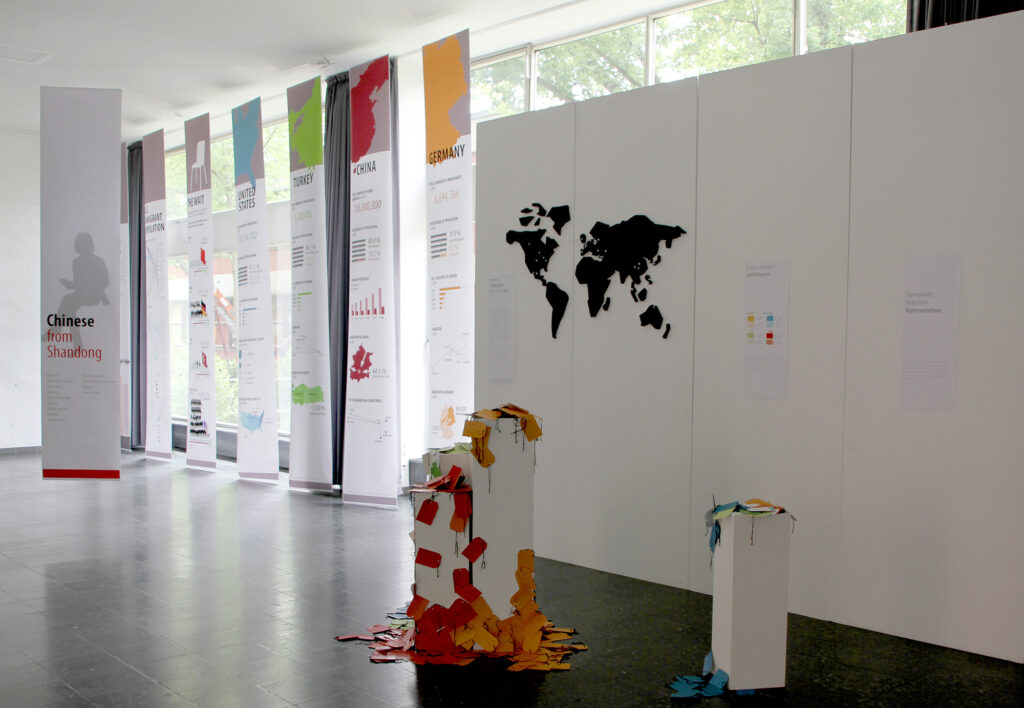Sticks + Stones 2010: Culture, Migration and Representation
In 2010, students from six international universities explored ways graphic design perpetuates and can negate stereotypes. Their work culminated in an exhibit at the DesignTransfer Gallery in Berlin, Germany.

Summary
This iteration of Sticks and Stones focused on migration as it relates visual culture. Students from China, England, Turkey, Germany, and the United States met in Berlin, Germany for a two-week symposium. Students bridged cultural and language barriers as they examined propaganda design’s role during World War II, completed activities and assignments about their similarities and differences, and researched migration-related issues. They then created design responses about their findings for an exhibition that was hosted by a Berlin venue.
Co-Authors
Mark Biddle, Charlotte Driessen, Ann McDonald, Ulrich Schwarz
Collaborating Institutions
Bilgi University (Turkey), Northeastern University (USA), Shandong University of Art & Design (China), Weber State University (USA), Universität der Künste Berlin (Germany), UMD
Details

Students from six universities — Bilkent University in Turkey, Shandong University of Art and Design in China, Universität der Künste in Germany, and Northeastern University, University of Maryland and Weber State University in the United States — participated in the 2010 project.
The DesignTransfer Gallery in Berlin hosted Sticks + Stones 2010 exhibit. Before the project, students interviewed first-generation migrants and immigrants in their home countries. Once everyone had arrived in Berlin, they then researched and discussed stereotyping and xenophobia content including historical and contemporary design examples that vilifying immigrants; France’s outlaw of the burqa; Nazi propaganda; current immigration conflicts in Germany and the U.S., and the human brain’s natural predisposition to stereotype. Students worked in inter-school groups to create a series of exhibit pieces related to this content.

The exhibit included information visuals addressing the costs, the financial expenses and rates of emigration and immigration to and from Germany, China, Turkey and the United States.
Project One: The T-Shirts
For one project collaborators ventured out in Berlin streets wearing a t-shirt asking “What would people call me behind my back?” They approached random people to write descriptions of the t-shirt wearer. This project made visible the otherwise invisible but potent stereotypes we hold of others.

These are a few of the t-shirts that were displayed in the exhibit.
Project Two: Interview Posters

A second group created a series of typographic posters using quotes from interviews with immigrants. Quotes such as “Your mind will never be in peace;” and “I want to go back.” added specific, first-person perspectives on what it is like to be an immigrant.
Project Three: Participation

A third group created participatory pieces. One project with a mural-size world map prompted visitors to denote their ideas of global locations by dipping their fingers into differently colored inkpads and then leave fingerprints on the corresponding map locations. Visitors placed purple thumbprints to denote where they currently live, green thumbprints where they want to live, and red thumbprints where they would never live. They could also add comments. Their responses yielded insights about their thoughts on different geographical identities.
For example, Mexico City yielded both red and green thumbprints and a comment stating “Too big,” whereas China received only green and purple thumbprints with comments declaring “I love it!!,” “It’s a beautiful place!,” and “I will live here forever.”
Project Four: Symposium Participant Posters

A fourth group sought to dispel stereotypes with posters of some of the symposium participants. On one side the posters listed the common stereotypes associated with this student, given his or her home region, religion, and assumed customs; the other side of the poster revealed which of these stereotypes were correct for that person, if any.
This series of posters was both playful and informative, challenging visitors to reconsider not only the stereotypes in front of them but others they might hold as well.